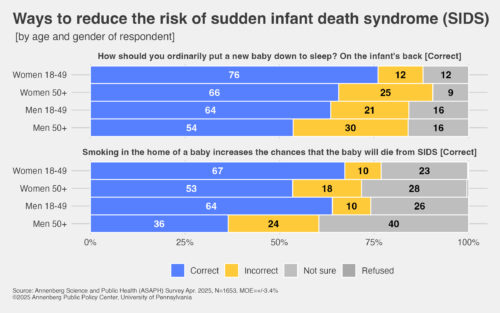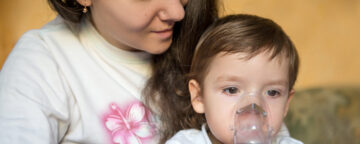Sudden infant death syndrome (SIDS) is the unexpected, unexplained, sudden death of a child younger than one year old. Although the number of babies born in the United States who die from SIDS annually has declined in recent decades, it is the most common cause of death among infants between one month and one year old, and some 2,300 babies die of it each year, according to Boston Children’s Hospital.
Yet new health survey data from the Annenberg Public Policy Center (APPC) of the University of Pennsylvania finds that many people do not know two consequential facts that could help reduce the number of SIDS deaths: First, babies under one year old should be put on their backs to sleep at all times, including naps. Infants sleeping on their backs are much less likely to die of SIDS, according to the Centers for Disease Control and Prevention (CDC). And second, babies exposed to secondhand smoke in a home are at greater risk for SIDS, the CDC reports.
Babies should be put to sleep on their backs
The APPC health survey, conducted in April with a nationally representative sample of more than 1,600 U.S. adults, finds that two-thirds (65%) know that ordinarily, a baby should be put to sleep on its back. But a third of those surveyed don’t know this: 12% say a baby should be put to sleep on its side, 9% say on its stomach, and 13% are not sure.
Adult women of childbearing age (18-49 years old) are more likely to know that the correct way to ordinarily put a baby to sleep is on the infant’s back. The survey finds that 76% of women in this age group say this, a significantly larger proportion when compared with men and older women: just 54% of men age 50 or older know this; 64% of men 18-49 years old; and 66% of women age 50 or older.
“Parents, grandparents, and anyone else caring for infants should know that it’s safest to place an infant on their back when putting them to sleep,” says APPC research analyst Laura A. Gibson. “Our data suggest that some potential caregivers may not be well-informed about this recommendation.”
Smoking at home is a risk for SIDS
Over half of those surveyed (56%) know that smoking in the home of a baby increases the chances that the baby will die from SIDS. But 15% incorrectly think this is false and 29% say they are not sure if it is true. Encouragingly, the percentage of those who believe this is definitely true rose from 18% in our June 2023 survey to 23% in April 2025, a statistically significant increase.
“Family discussions of the effects of secondhand smoke need to include the reminder that its effects on infants can be profound,” says Ken Winneg, APPC’s managing director of survey research.
Younger adults (18-49 years old) are more likely than older adults to know that smoking in a home increases the risk of SIDS. The survey finds that 67% of women 18-49 years old and 64% of men in this same age group know this is true, significantly larger proportions than the 53% of older women and 36% of older men who know this. Notably, 40% of older men say they are not sure whether smoking in the home increases the risk of SIDS deaths among infants, more than other groups.
Annenberg Science and Public Health survey
The survey data come from the 24th wave of a nationally representative panel of 1,653 U.S. adults conducted for the Annenberg Public Policy Center by SSRS, an independent market research company. Most have been empaneled since April 2021. To account for attrition, replenishment samples have been added over time using a random probability sampling design. The most recent replenishment, in September 2024, added 360 respondents to the sample. This wave of the Annenberg Science and Public Health (ASAPH) survey was fielded April 15-28, 2025. The margin of sampling error (MOE) is ± 3.4 percentage points at the 95% confidence level. All figures are rounded to the nearest whole number and may not add to 100%. Combined subcategories may not add to totals in the topline and text due to rounding.
Download the topline and the methods report.
The policy center has been tracking the American public’s knowledge, beliefs, and behaviors regarding vaccination, Covid-19, flu, RSV, and other consequential health issues through this survey panel for four years. APPC’s ASAPH team consists of research analyst Laura A. Gibson, Patrick E. Jamieson, director of the Annenberg Health and Risk Communication Institute, and Ken Winneg, managing director of survey research.
See other recent Annenberg health survey news releases:
- Mammogram screenings: Survey finds some confusion over mammogram guidelines (June 30, 2025)
- High blood pressure: Many Americans unaware high blood pressure usually has no noticeable symptoms (June 6, 2025)
- Measles and the MMR vaccine: Americans say benefits of MMR vaccine for children outweigh risks by nearly 5-1 (May 16, 2025)
- Raw milk and bird flu: With bird flu in raw milk, many still do not know risks of consuming it (March 14, 2025)
- Firearm safety: Over 1 in 3 adults in households with guns do not store all in locked locations (March 11, 2025)
The Annenberg Public Policy Center was established in 1993 to educate the public and policy makers about communication’s role in advancing public understanding of political, science, and health issues at the local, state, and federal levels. Connect with us on Facebook, X, Instagram, and Bluesky.



